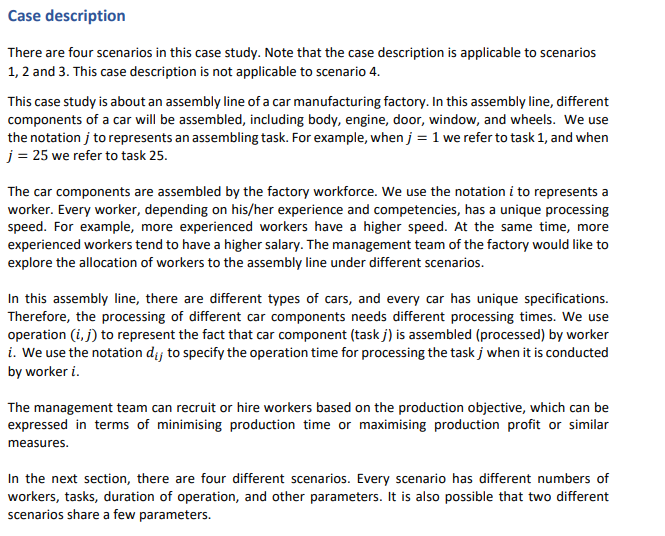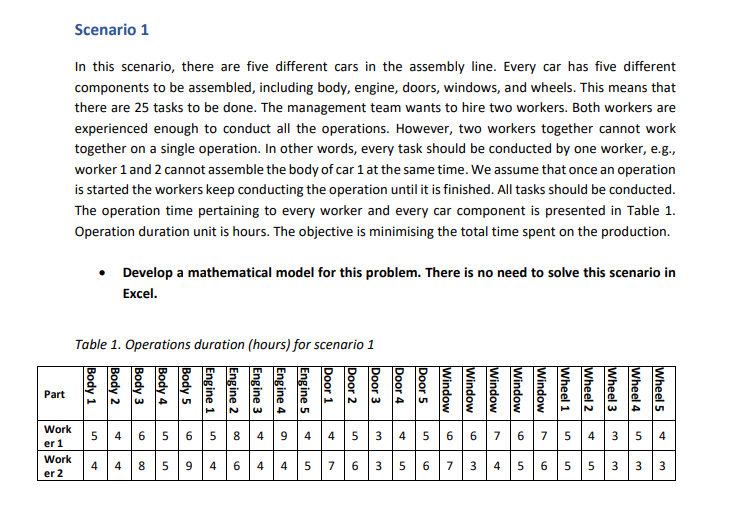Answered step by step
Verified Expert Solution
Question
1 Approved Answer
Thats all the info given Case description There are four scenarios in this case study. Note that the case description is applicable to scenarios 1,


Thats all the info given
Case description There are four scenarios in this case study. Note that the case description is applicable to scenarios 1, 2 and 3. This case description is not applicable to scenario 4. This case study is about an assembly line of a car manufacturing factory. In this assembly line, different components of a car will be assembled, including body, engine, door, window, and wheels. We use the notation ; to represents an assembling task. For example, when j = 1 we refer to task 1, and when j = 25 we refer to task 25. The car components are assembled by the factory workforce. We use the notation i to represents a worker. Every worker, depending on his/her experience and competencies, has a unique processing speed. For example, more experienced workers have a higher speed. At the same time, more experienced workers tend to have a higher salary. The management team of the factory would like to explore the allocation of workers to the assembly line under different scenarios. In this assembly line, there are different types of cars, and every car has unique specifications. Therefore, the processing of different car components needs different processing times. We use operation (i, j) to represent the fact that car component (taskj) is assembled (processed) by worker i. We use the notation dij to specify the operation time for processing the task j when it is conducted by worker i. The management team can recruit or hire workers based on the production objective, which can be expressed in terms of minimising production time or maximising production profit or similar measures. In the next section, there are four different scenarios. Every scenario has different numbers of workers, tasks, duration of operation, and other parameters. It is also possible that two different scenarios share a few parameters. Scenario 1 In this scenario, there are five different cars in the assembly line. Every car has five different components to be assembled, including body, engine, doors, windows, and wheels. This means that there are 25 tasks to be done. The management team wants to hire two workers. Both workers are experienced enough to conduct all the operations. However, two workers together cannot work together on a single operation. In other words, every task should be conducted by one worker, e.g., worker 1 and 2 cannot assemble the body of car 1 at the same time. We assume that once an operation is started the workers keep conducting the operation until it is finished. All tasks should be conducted. The operation time pertaining to every worker and every car component is presented in Table 1. Operation duration unit is hours. The objective is minimising the total time spent on the production. Develop a mathematical model for this problem. There is no need to solve this scenario in Excel. Table 1. Operations duration (hours) for scenario 1 Body 1 Body 2 Body 3 Body 4 Body 5 Engine 1 Engine 2 Engine 3 Engine 4 Engine 5 Door 1 Door 2 Door 3 Door 4 Door 5 Window Window Window Window Window Wheel 1 Wheel 2 Wheel 3 Part Wheel 4 Wheel 5 5 4 6 5 6 5 8 4 9 4 4 5 3 4 6 6 7 6 7 5 4 un 4 Work er 1 Work er 2 4 4 8 5 9 4 4 6 4 4 5 7 6 3 3 5 6 7 3 4 5 6 5 5 3 3 3 3 Case description There are four scenarios in this case study. Note that the case description is applicable to scenarios 1, 2 and 3. This case description is not applicable to scenario 4. This case study is about an assembly line of a car manufacturing factory. In this assembly line, different components of a car will be assembled, including body, engine, door, window, and wheels. We use the notation ; to represents an assembling task. For example, when j = 1 we refer to task 1, and when j = 25 we refer to task 25. The car components are assembled by the factory workforce. We use the notation i to represents a worker. Every worker, depending on his/her experience and competencies, has a unique processing speed. For example, more experienced workers have a higher speed. At the same time, more experienced workers tend to have a higher salary. The management team of the factory would like to explore the allocation of workers to the assembly line under different scenarios. In this assembly line, there are different types of cars, and every car has unique specifications. Therefore, the processing of different car components needs different processing times. We use operation (i, j) to represent the fact that car component (taskj) is assembled (processed) by worker i. We use the notation dij to specify the operation time for processing the task j when it is conducted by worker i. The management team can recruit or hire workers based on the production objective, which can be expressed in terms of minimising production time or maximising production profit or similar measures. In the next section, there are four different scenarios. Every scenario has different numbers of workers, tasks, duration of operation, and other parameters. It is also possible that two different scenarios share a few parameters. Scenario 1 In this scenario, there are five different cars in the assembly line. Every car has five different components to be assembled, including body, engine, doors, windows, and wheels. This means that there are 25 tasks to be done. The management team wants to hire two workers. Both workers are experienced enough to conduct all the operations. However, two workers together cannot work together on a single operation. In other words, every task should be conducted by one worker, e.g., worker 1 and 2 cannot assemble the body of car 1 at the same time. We assume that once an operation is started the workers keep conducting the operation until it is finished. All tasks should be conducted. The operation time pertaining to every worker and every car component is presented in Table 1. Operation duration unit is hours. The objective is minimising the total time spent on the production. Develop a mathematical model for this problem. There is no need to solve this scenario in Excel. Table 1. Operations duration (hours) for scenario 1 Body 1 Body 2 Body 3 Body 4 Body 5 Engine 1 Engine 2 Engine 3 Engine 4 Engine 5 Door 1 Door 2 Door 3 Door 4 Door 5 Window Window Window Window Window Wheel 1 Wheel 2 Wheel 3 Part Wheel 4 Wheel 5 5 4 6 5 6 5 8 4 9 4 4 5 3 4 6 6 7 6 7 5 4 un 4 Work er 1 Work er 2 4 4 8 5 9 4 4 6 4 4 5 7 6 3 3 5 6 7 3 4 5 6 5 5 3 3 3 3Step by Step Solution
There are 3 Steps involved in it
Step: 1

Get Instant Access to Expert-Tailored Solutions
See step-by-step solutions with expert insights and AI powered tools for academic success
Step: 2

Step: 3

Ace Your Homework with AI
Get the answers you need in no time with our AI-driven, step-by-step assistance
Get Started


